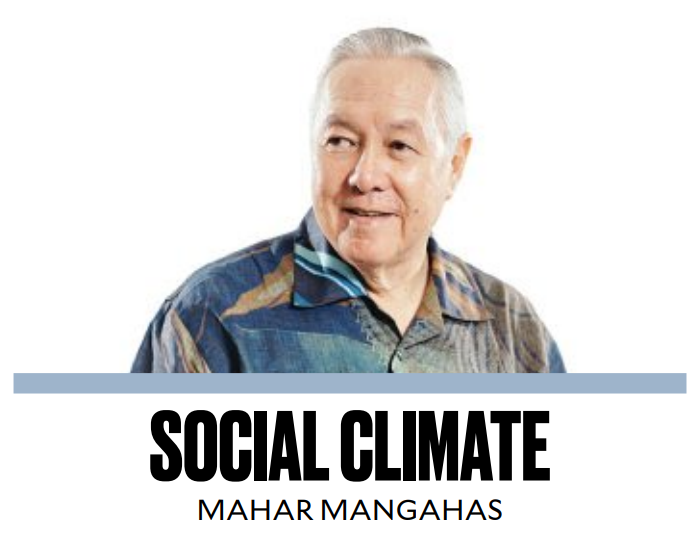Self-Rated Poverty stays high

The first release from the Third Quarter 2024 Social Weather Report came out last Wednesday: “Self-Rated Poverty (SRP) at 59% in September, up from 58% in June 2024; Borderline at 13%, Not Poor at 28%,” (www.sws.org.ph, 10/9/24).
Social Weather Stations (SWS) regularly surveys SRP–“Poverty as defined by the poor,” (8/4/24)–by face-to-face interviews with a Poor versus Not Poor show-card. From 1986-1991, it surveyed SRP 11 times. In 1992, it started doing it quarterly (missing three rounds in 2020 due to the lockdown). The September 2024 round is the 144th SRP-survey to date, counting SWS-precursors in 1983 and 1985.
No other measure of poverty has statistical data either earlier or later than SRP. SRP has been volatile; its plentiful surveys show two-thirds of all consecutive movements as statistically significant. (Think of a fire alarm that’s guaranteed to work when needed.) Counting only the significant changes, the net long-term trend of SRP is downward over time–thank goodness–because the falls outnumber the rises.
Long-term movements in SRP. Every SRP release includes the whole history of previous findings. It becomes history, Ambeth Ocampo told me, as soon as the primary source materials, i.e., the recorded interviews, are archived.
SRP peaked at 74 percent in 1985; it was in the 70s five times up to 1994, and very often in the 60s in 1995-2003. It simmered down to the 50s in 2004-2015, and then the 40s starting 2016, until reaching its all-time low 38 percent in early 2019. Then, not counting the period lost by the pandemic, SRP averaged in the mid-to-upper 40s in 2020-2023. This year, its average is 54 percent so far.
Most recent SRP numbers. SRP among families was already quite high in June 2024, having jumped by 12 points, from 46 percent last March. The extra point added from June to September is not significant, of course.
What I find most interesting is that: (a) the latest 28 percent Not Poor (Hindi Mahirap) is very near its all-time-high 30 percent last June; and (b) the latest 13 percent Borderline is very near its all-time-low 12 percent last June. This shows the Not Poor drifting away from the Poor, and those in-between getting fewer.
The SWS report also includes a series of surveys on the Self-Rated Food Poor, the Self-Rated Not Food Poor, and, of course, the Borderline between the two. This series is slightly shorter than that of SRP since it started in 1998.
Poverty Thresholds and Poverty Gaps. The families that rate themselves as Poor are asked how much they need for home expenses per month so as not to feel that way. This gives their Self-Rated Poverty Threshold. Then they are asked how much they lack to reach the threshold; this gives their Poverty Gap. In the National Capital Region (NCR), in September 2024, the median Poverty Threshold is P18,000 per month, and the median Poverty Gap is P8,000 per month. The medians mark the mid-points of the answers of the poor.
Those that rate themselves as Food-Poor–in terms of food quality, not quantity–likewise reveal their Self-Rated Food Poverty Threshold, and their Food Poverty Gap. In NCR, the latest median Food Poverty Threshold is P10,000 per month and the median Food Poverty Gap is P3,000 per month.
I cited here the numbers for NCR in particular on the premise that it is the area most familiar to Inquirer readers, who may judge for themselves whether the thresholds are exaggerations. See the SWS report for counterpart findings for Balance of Luzon, Visayas, and Mindanao.
Official poverty has just gone from triennial to biennial. The official figures on poverty are generated by the Philippine Statistics Authority (psa.gov.ph), using the orthodox method of (a) choosing an economic indicator, family income (but expenditure would be superior), (b) constructing an official poverty boundary for this indicator, and (c) determining, by means of a survey, the proportion of families/individuals below the boundary. This has its pros and cons, but its most critical element, to me, is its frequency of application.
The frequency of PSA poverty measurement depends on that of the Family Income and Expenditure Survey (FIES), which started in 1985 and was done every three years up to 2021. When the official standard was revised in 2011 (see “The lowering of the official poverty line,” 2/12/11), the PSA applied the new line to the 2009 FIES and a few (not all) earlier FIES years.
The FIES went biennial–which is nice, but I would go annual–in 2023; hence, the latest PSA poverty report, published last August, has data for reference years 2018, 2021, and 2023. There are no official poverty numbers for 2019, 2020, and 2022, and there won’t be any for 2024. The next official report will refer to 2025, and may be expected only in mid-2026, two years from now.
Meanwhile, what has happened to Philippine poverty since last year? Or since last quarter? What might happen next year, or next quarter? Can the rosy trend in the PSA numbers of 2021 and 2023 be extrapolated? The most dependable way to stay abreast of Philippine poverty is to watch Self-Rated Poverty.
—————-
mahar.mangahas@sws.org.ph
Dr Mahar Mangahas is a multi-awarded scholar for his pioneering work in public opinion research in the Philippines and in South East Asia. He founded the now familiar entity, “Social Weather Stations” (SWS) which has been doing public opinion research since 1985 and which has become increasingly influential, nay indispensable, in the conduct of Philippine political life and policy. SWS has been serving the country and policymakers as an independent and timely source of pertinent and credible data on Philippine economic, social and political landscape.





















